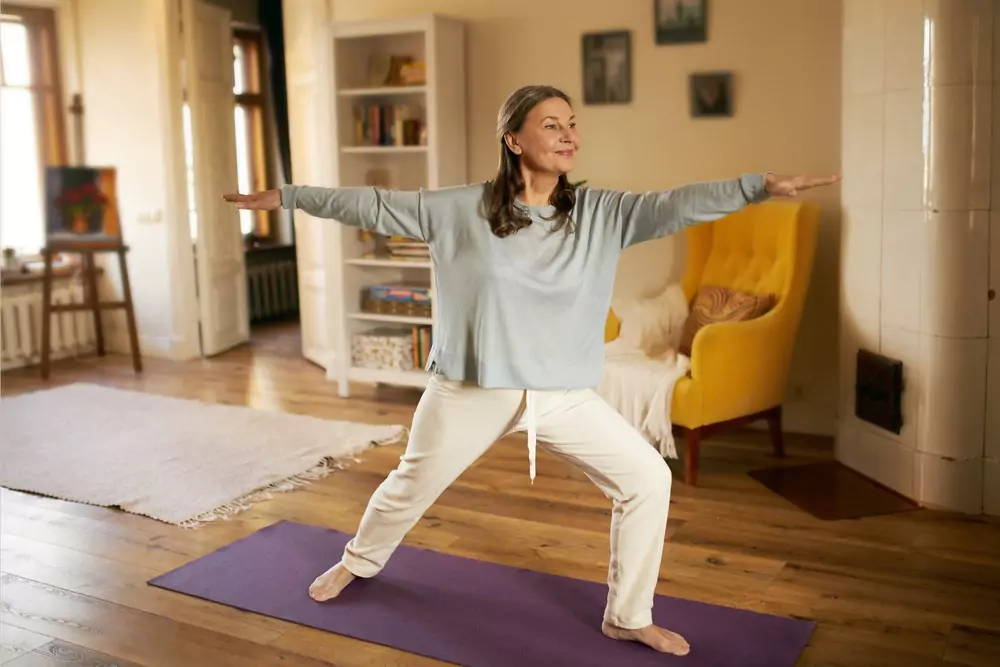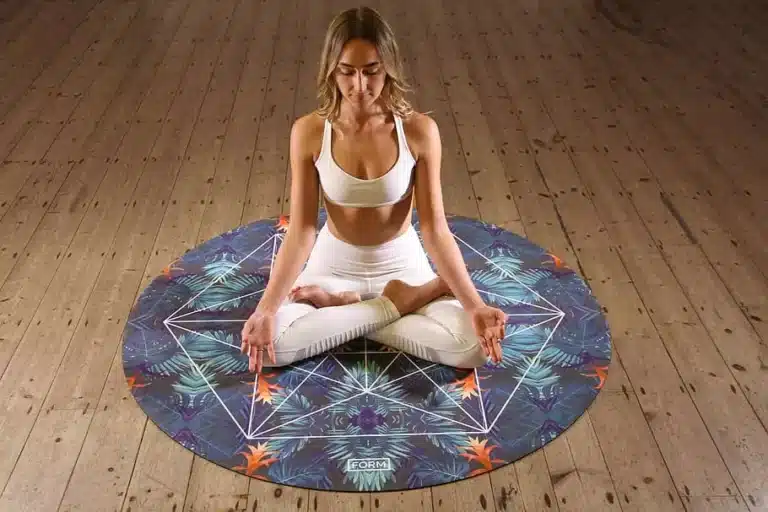Is Yoga Mat Necessary for Exercise? Uncovering the Truth

Are you wondering if you really need a yoga mat for your workouts? The answer might surprise you. While it’s not technically essential for exercise, a yoga mat can greatly enhance your workout routine in many ways.
Using a yoga mat provides numerous benefits, from enhanced comfort and joint support to better safety and stability during exercise. Over here, we’ll explore the various advantages of using a yoga mat, as well as provide tips on choosing the right one for your needs and how to properly maintain it.
The Benefits of Using a Yoga Mat
When it comes to exercise equipment, a yoga mat is often considered an essential item. While some may argue that it’s not necessary, using a yoga mat during exercise comes with several benefits that make it a valuable addition to your workout routine.
One of the primary benefits of using a yoga mat is the cushioning and support it provides. Unlike hard or uneven surfaces, a yoga mat creates a soft and stable base for your exercises, preventing strain on your joints and muscles. This benefit is particularly important for individuals with injuries or joint issues, as it reduces impact and allows for a more comfortable workout.
Another advantage of using a yoga mat is its ability to improve stability and balance during exercises. The non-slip surface of a yoga mat ensures that you have proper footing, preventing slips and falls that could lead to injury. This added stability also allows you to focus on your form and technique, maximizing your results.
A yoga mat also offers emotional benefits. Using a yoga mat creates a designated space for your workouts, promoting mindfulness and a sense of ownership. This psychological advantage can lead to a more enjoyable and effective exercise experience, making it easier to stick to your routine for the long term.
With its versatility and adaptability, a yoga mat can be used for a wide variety of exercises, from yoga and Pilates to stretching and bodyweight exercises. This makes it a practical and worthwhile investment for anyone looking to enhance their fitness routine.
Using a yoga mat during exercise provides a range of benefits that make it a valuable addition to your fitness accessories. From cushioning and support to stability and personal space, a yoga mat is an investment that can enhance your workouts in multiple ways.
Enhancing Safety and Stability
Using a yoga mat during exercise not only provides comfort, but it also enhances safety and stability. The non-slip surface of a yoga mat ensures that your feet and hands remain in place, preventing any unwanted slipping or sliding during a workout.
The stability provided by a yoga mat is especially important during standing poses, balancing exercises, and inversions. The cushioning of the mat creates a secure base and allows for better weight distribution, decreasing the risk of falls or injuries.
A yoga mat is designed to absorb shock, reducing the impact on joints during high-impact exercises. This added cushioning also allows for a wider range of movements and deeper stretches without the risk of discomfort or injury.
Comfort and Joint Support
A yoga mat provides more than just a surface to exercise on. The cushioning of the mat can reduce the impact on joints, making it easier to perform exercises without discomfort. This is especially important for those with knee or wrist issues, who may find it difficult to perform exercises on a hard surface.
The thickness of the mat also affects its ability to provide joint support. Thinner mats are great for balance and stability, but they may not provide enough cushioning for some exercises. Thicker mats are ideal for exercises that require more support, such as kneeling or seated poses.
Versatility and Adaptability
One of the best things about a yoga mat is its versatility. While it is commonly associated with yoga, a yoga mat can be used for a wide range of exercises and activities, making it an essential fitness accessory.
If you’re into Pilates, a yoga mat can provide the cushioning and stability you need for your routine. For stretching exercises, a yoga mat can offer a comfortable and non-slip surface to support your movements. Bodyweight exercises such as push-ups and planks can also benefit from the added stability and traction of a yoga mat.
A yoga mat can be used for outdoor workouts or wherever a clean and stable surface is not readily available. It provides a portable and convenient exercise surface that you can take with you wherever you go.
Yoga Mat for Hot Yoga and Sweaty Workouts
For those who enjoy hot yoga or other sweaty workouts, having a yoga mat with a non-slip surface is crucial. A yoga mat’s grip ensures that you won’t slip or slide during poses, even when your body is sweaty.
When choosing a yoga mat for hot yoga or high-sweat workouts, look for mats made from materials such as PVC, which offers excellent traction and grip. Some yoga mats are also specifically designed for hot yoga, with a textured or perforated surface to enhance grip and ventilation.
Yoga Mat as a Personal Space
A yoga mat is more than just an exercise accessory – it can also serve as a personal space for your workouts. Having a designated area for your exercise routine can help create boundaries and promote mindfulness during your sessions.
When you step onto your yoga mat, you enter a space that is uniquely yours. It’s an area where you can disconnect from outside distractions and focus solely on your practice.
This sense of ownership and personal space can create a positive and empowering mindset, helping to build confidence and motivation in your fitness journey.
The Psychological and Emotional Benefits
Aside from the physical benefits, using a yoga mat as a personal space can also have various psychological and emotional benefits.
“When you create a safe space that is all your own, you can relax and be present, and that’s when the magic happens.” – Yoga Journal
By having a designated area for your workouts, you can create a sense of ritual and routine, making exercise a regular and enjoyable part of your daily life. It’s a space where you can let go of stress and tension, connecting with your body and mind in a meaningful way.
Whether you’re practicing yoga, Pilates, or any other form of exercise, a yoga mat is the perfect tool to create your own personal space and enhance your overall workout experience.
Choosing the Right Yoga Mat
When it comes to selecting a yoga mat, there are a few factors to consider to make sure you choose the right one for your needs. Here are some tips to help you make an informed decision:
| Factor | Consideration |
|---|---|
| Thickness | Thicker mats provide more cushioning, but can be heavier and less portable. Thinner mats, on the other hand, are easier to carry around but offer less support. |
| Material | There are various materials to choose from, including PVC, rubber, cotton, and jute. Each has its own pros and cons in terms of durability, grip, and environmental impact. |
| Texture | Some mats have a sticky surface for better traction, while others have a smooth finish. Consider the type of exercise you will be doing and your personal preference for comfort. |
| Durability | A good quality yoga mat should last for several years without losing its shape or grip. Look for a mat with a solid warranty and good reviews from other users. |
Ultimately, the best yoga mat for you will depend on your individual needs and preferences. Don’t be afraid to try out different mats and see which one works best for you. Keep in mind that investing in a high-quality yoga mat can make a big difference in your exercise routine.
Maintaining and Cleaning Your Yoga Mat
A yoga mat is an essential investment for anyone who practices yoga, Pilates, or other forms of exercise. To get the most out of your mat, it’s important to take good care of it. Proper maintenance and cleaning will not only help your yoga mat last longer but will also ensure that it remains hygienic for your health and wellness.
Cleaning Your Yoga Mat
It’s important to clean your yoga mat regularly to remove dirt, sweat, and bacteria that accumulate after each use. You can clean your yoga mat using a simple solution made from water and mild soap. Mix equal parts of water and soap and apply the mixture to your mat, using a sponge or soft cloth to gently scrub it. Rinse your mat thoroughly with clean water and then dry it with a towel or hang it to air dry. Avoid using harsh detergents, bleach, or any other cleaning solutions that may damage the material of your mat.
If you prefer, you can also use a yoga mat cleaning spray to clean your mat. Simply spray the solution onto your mat and wipe it clean with a cloth or towel. Depending on how often you use your mat, you may want to clean it once a week or more frequently.
Maintaining Your Yoga Mat
It’s important to take good care of your yoga mat to ensure its longevity and performance. Here are some tips to help you maintain your yoga mat:
- Avoid exposing your mat to direct sunlight or extreme temperatures, which can cause it to degrade and lose its grip.
- Avoid folding your mat, as this can cause creases that may damage the material.
- Store your mat in a clean, dry place when not in use, preferably in a yoga mat bag or a rolled-up position.
- Avoid wearing shoes or jewelry on your mat, as these can cause scratches or tears.
- Consider investing in a yoga towel, which can provide extra protection and traction while also absorbing sweat.
Following these tips will help keep your yoga mat in excellent condition, ensuring that it provides you with the comfort, stability, and support you need during your exercise routine.
FAQ – Is a Yoga Mat Really Necessary for Exercise?
After exploring the benefits, safety, and comfort provided by a yoga mat, you may still have questions about its necessity for exercise. Here are some commonly asked questions:
Can’t I just exercise on the floor?
While exercising on the floor is possible, it may not provide the necessary cushioning and support that a yoga mat can offer. Additionally, a yoga mat provides a designated space for your workout, promoting a sense of discipline and mindfulness.
What if I have a carpeted floor?
Even with a carpeted floor, a yoga mat can still offer additional support and stability during your exercise routine. Plus, using a mat ensures that your carpet stays clean and free from sweat and dirt.
What if I don’t practice yoga?
While a yoga mat is commonly used for yoga, it is also suitable for a variety of other exercises such as Pilates, bodyweight exercises, and stretching. Its versatility makes it a must-have for any fitness enthusiast.
Do I need to buy an expensive yoga mat?
No, you don’t have to buy an expensive yoga mat to enjoy its benefits. There are plenty of affordable options available that can still provide the necessary support and cushioning for your workouts.
How do I clean my yoga mat?
To keep your yoga mat clean and hygienic, wipe it down with a mild detergent or a mix of water and vinegar after each use. It’s also a good idea to let your mat air dry completely before rolling it up for storage.
Overall, while a yoga mat may not be absolutely necessary for exercise, it can greatly enhance your workout routine and help you achieve your fitness goals with comfort and safety. Investing in a good quality yoga mat is definitely worth it in the long run.





